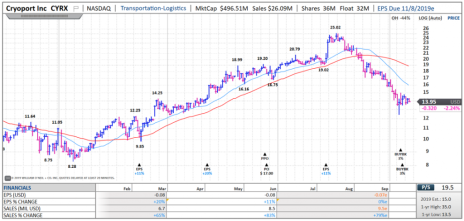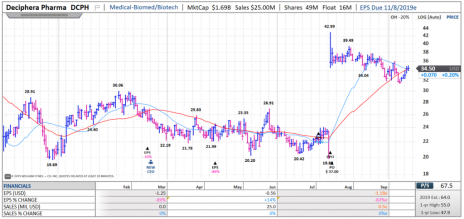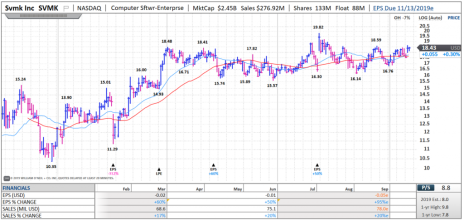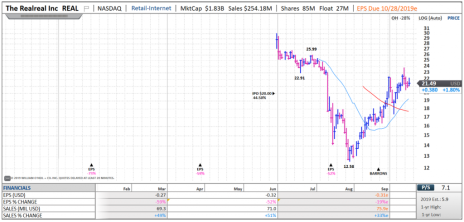The nature of this newsletter is that 90% of our focus is centered on finding early-stage opportunities and vetting them. But to have investing success – in any type of stocks – over the long haul we must follow some basic portfolio management strategies.
This month I’m laying out five simple tips that you should follow when investing in the stock I feature in these pages. There is nothing that’s super innovative or worth discussing at a cocktail party here. No hedging or options trading techniques. Just solid, basic, common sense tips that will help you reduce risk, increase your probability of success, and sleep better at night.
Cabot Early Opportunities 102
Stocks in this Issue
Five Portfolio Management Tips for Early-Stage Stocks
The nature of this newsletter is that 90% of our focus is centered on finding early-stage opportunities and vetting them. But to have investing success – in any type of stocks – over the long haul we must follow some basic portfolio management strategies.
This month I’m laying out five simple tips that you should follow when investing in the stock I feature in these pages. There is nothing that’s super innovative or worth discussing at a cocktail party here. No hedging or options trading techniques. Just solid, basic, common sense tips that will help you reduce risk, increase your probability of success, and sleep better at night.
Position Sizing
The capital you allocate to an early-stage stock should be less than what you allocate to a large cap or blue chip stock. Why? Because the upside potential, and the downside potential, is greater.
Stay Diversified
Diversification helps your portfolio weather downturns. It is comforting and leads to greater profits over time because it stops you from freaking out if a couple of your stocks get whacked. But too many investors have too narrow definition of diversification, thinking it means holding lots of stocks. That’s not true. Think of diversification across many more dimensions than just the number of stocks, including diversification across industries, trends, market caps and time (i.e. dollar cost averaging, see below). I won’t talk too much about diversification in Cabot Early Opportunities. But the concept underpins many of the decisions I make when considering stocks in every Issue.
Dollar Cost Averaging
This is the practice of buying a stock at different times and prices to spread out your cost basis and reduce the risk of unlucky timing. There are two ways to dollar cost average. You can average down, which means buying more shares of a stock that you currently have a loss on. This reduces your cost basis. Or, you can average up. This means buying more shares of a stock that you currently have a gain on. This increases your cost basis. Most successful investors do both, depending on the circumstances.
As a side note, I’ve found that dollar cost averaging helps investors take that initial plunge to buy a potential big winner. Why? Because buying a small position in a new stock, with the intention to buy more later, is a much lower commitment than buying a big position in a stock you’re not sure of.
Use Stop Losses
The reality is that early-stage stocks tend to be more volatile than the broad market. Use of stop losses helps you lower risk by drawing a line in the sand that defines where it’s time to sell. This can help you avoid big losses, while giving you the confidence to invest in high potential stocks. For early-stage stocks, I suggest a stop loss around -20%. This means that when you own a full position in a stock that is down -20% from your entry level it’s time to sell. You can give a little wiggle room here and there depending on the chart and the fundamentals—but don’t push it. Adherence to a stop loss strategy allows you fight another day. It’s not an admission of defeat.
Stay in Your Comfort Zone
One of my biggest priorities is to help investors stay in their comfort zones. How do you know when you’ve strayed too far? You don’t sleep well. If you find yourself lying awake at night concerned about your allocation to early-stage stocks (or any investment for that matter), it’s time to pull back a little. This isn’t to say that I don’t encourage calculated risk taking. I do. But that risk taking must always occur within the confines of your comfort zone.
WHAT TO DO NOW
Keep averaging into attractive opportunities, but don’t overdo it. The market is moving sideways, and in the absence of a clear trend there’s no reason to make outsized bets. Do some buying here and there, cut losers short, and keep plenty of money in cash so you have the flexibility and clarity of mind to take more decisive action when it’s time.
Earnings season is ramping up and that means stocks are starting to jump around, sometimes for no apparent reason. In this environment speculation about what earnings results mean for the U.S. and global economies, competing businesses, and interest rate policy are driving a lot of individual stock action.
It’s only going to get more intense over the next five weeks, which is when the bulk of growth stocks in the technology and MedTech sectors will report. To balance things out, implement the portfolio management techniques I mentioned above.
On that note, in this Issue of Cabot Early Opportunities I’ve spread things around. We have a smallish mid-cap stock in Frontdoor (FTDR) that was recently spun out and is growing slowly but steadily providing home service plans in the U.S. We have a high potential software stock in SurveyMonkey (SVMK) that’s not entirely understood and should see growth accelerate.
Then there’s The RealReal (REAL), this month’s Top Pick, a recent IPO, and a small cap stock that lacks a clear trend, but which represents a business that’s fresh and different and has huge potential.
Rounding things out are Cryoport (CYRX), which provides logistics services for the life sciences industry, and Deciphera Pharmaceutics (DCPH), an emerging biotech company with molecules that beat back cancer.
Enjoy!
Cryoport (CYRX)
Cryoport (CYRX) specializes in cold chain logistics solutions for temperature-sensitive life sciences materials. It offers end-to-end solutions that span protection, monitoring, logistics, storage and chain of compliance. It primarily serves the biopharmaceutical market, but also generates revenue from IVF and animal health markets. Cryoport moves and stores everything from stem cells and embryos to vaccines, tissues and biologics. This means there are often lives and company-defining trials on the line.
One product example is the new C3 2-8°C solution. This box, which is slightly larger than one cubic foot, includes all the technology needed to keep its contents between three and eight degrees Celsius for up to 96 hours. It also includes the required platform technology to show exactly where the package is, as well the temperature, humidity, and pressure inside the container
Growth is the main attraction here. In 2018 revenue rose by 64%, to $19.6 million. In Q2 2019 revenue was up 83% to $8.5 million and Cryoport was supporting 413 regenerative therapy clinical trials (up from 357 at the end of 2018).
Growth is currently being driven by agreements to support the global rollouts of Gilead’s (GILD) YESCARTA and Novartis’ (NVS) KYMRIAH. Cryoport also won a deal to support the rollout of Bluebird Bio’s (BLUE) NYNTEGLO. Analysts see revenue up 50% in 2019 and 67% in 2020. Cryoport isn’t yet profitable, but the trend is improving. Analysts expect an EPS loss of -$0.25 in 2019 and -$0.08 in 2020.
This isn’t a low risk stock. Cryoport’s market cap is just $505 million and there are competitors out there. The company has also come under fire from several short sellers on Seeking Alpha. Now that shares are 40% off their high the short sellers aren’t as likely to jump all over it! But Cryoport’s Board of Directors sure are. With almost $95 million in cash and a share price trading around 14, Cryoport just announced a share buyback program of up to $15 million. As with any high-risk stock, average in.
The Stock
CYRX came public via reverse merger in 2005 when it was still a development stage penny stock. It began to climb off the 2 level in 2017 and was up to 17 by July 2018. It then slid back to 10 at the end of the year. Another rally began in January 2019 and didn’t fizzle out until CYRX hit 25 in mid-August. Shares then slid again, back to around 14, where they are now. Given the size of the pullback and the recent buyback announcement, risk-tolerant investors can step in here with an initial position.
Deciphera Pharmaceutics (DCPH)
Deciphera is a $1.7 billion market cap company that develops novel drug candidates to fight cancer. It has developed a proprietary kinase switch control inhibitor platform that focuses on the switch pocket, which is the region of the kinase (a family of enzymes) that transforms it from an inactive to an active state. This focus on the switch pocket region is what makes Deciphera’s molecules different from the competition.
The company currently has four programs, primarily targeting solid tumors. Ripretenib is the lead drug candidate and is being developed to target gastrointestinal stromal tumors (GIST), and to inhibit forms of kinases that are involved in gliomas (brain and spinal cord tumors) and advanced systemic mastocytosis (ASM), in which far too many mast cells accumulate in one or more organs.
Ripretenib is in headlines because top-line results (announced August 13) for the INVICTUS Phase 3 trial for 4th line GIST were far better than expected. On the back of that news management began work on a U.S. marketing application and commercial rollout strategy to make the drug candidate available for patients who have received at least three prior therapies. Word on the street is that pricing could range from $17 - $32 million and that 40 to 60 sales reps would be needed to launch in the U.S.
The strong data also raised the probability of success in the INTRIGUE Phase 3 trial for 2nd line GIST, which could dramatically increase ripretenib’s market potential as it would become available for patients who have only received one anticancer treatment. The next update on this trial comes soon; there is a meeting to go over Phase 1 data on October 26 – 30 in Boston, after which management should be able to speak to some components of the INTRIGUE trial.
Deciphera is also moving rebastinib through Phase 1b/2 trials for a variety of solid tumors (breast, ovarian, endometrial and mesothelioma) and DCC-3014 through a Phase 1 trial for solid tumors. Data on both are likely to be discussed at the Boston meeting as well. While the company is moving toward commercialization and management says it is well funded for now, this is still an early-stage story so invest accordingly.
The Stock
DCPH came public at 17 in September 2017 and had moved into the high 20s by summer 2019. There was a spike above 40 in July 2018, but shares fell back to earth and consolidated in the 20 to 30 range through the first seven months of 2019. When the ripretenib data came out DCPH shot up into the mid-30s. It pulled back to 32 a couple weeks ago but is back above 34 now. It looks like a good time to establish a starter position.
Frontdoor (FTDR)
Frontdoor is the biggest provider of home service plans in the U.S. It is roughly four times bigger than its next closest competitor, has over 16,000 pre-qualified contractor firms and 45,000 technicians, and completes over four million jobs a year. That significant presence has made the company, which has roughly two million customers and nearly 50% market share, a clear leader in the home service plan market.
Given that Frontdoor launched the home service plan industry 45 years ago, it’s not exactly a spring chicken. But until September 2018 the company was part of Servicemaster (SERV). Following a recent spin-out, Frontdoor has entered a new stage of life, which should allow it to spread its wings. That means circling the wagons around its four existing brands; American Home Shield, HSA Home Warranty, Landmark and Oneguard, as well as tackling new initiatives.
The most intriguing opportunities surround management’s business development plans, which incude expansion into home maintenance and repair (75% of the $400 billion home services market) and offering on-demand services. Both of these initiatives are aimed at reducing the costs and hassles associated with homeownership, while leveraging Frontdoor’s business model, scale and technology platform to increase profit margins.
The on-demand pilot, which just launched, is particulary compelling. It is being marketed into Frontdoor’s existing home service plan customer base and intially offers repairs, with preventitive maintenance and improvement services coming later, all with transparent pricing. While this program will take some investment now and won’t contribute to revenue until 2020, the potential is huge.
In the meantime, investors get a best-of-breed company that’s 100% focused on driving steady growth through both the real estate and direct-to-consumer channels, while pushing customer retention above 75%. Revenue should grow at around 9% this year (to $1.37 million) and next, while EPS growth should be closer to 20% this year (to $1.83) then in the low teens in 2020.
The Stock
FTDR was spun out of SERV and began trading as an independent stock at 42 in October 2018. Shares initially fell, found a bottom around 20 in November, and have been mostly making a series of higher highs and higher lows since, with a few consolidation phases here and there. The stock has been consolidating in the 46.5 to 53 range since it gapped up from 44 to 50.5 following the Q2 earnings release on August 8.
Survey Monkey (SVMK)
Survey Monkey (SVMK) is the leading online survey platform for businesses. With 20 million questions answered daily the company owns a database treasure trove of almost 50 billion questions, giving it by far the largest dataset for survey questions out there. Not only does this make it tough for the competition (SAP/Qualtrics, Google Forms, Microst Forms, Medallia, etc.) to catch up, the depth of SurveyMonkey’s data set opens up interesting opportunites to create new revenue-generating solutions.
The company was founded by Ryan and Chris Finley in 1999 and just went public in 2018. It’s well-known in the business community, which represents 80% of users. While most users aren’t aware of the secret sauce that makes the platform’s artificial intelligence and machine learning technologies tick, they are well-aware of how it helps them better engage and understand customers, employees and target market forces.
The business model is based on delivering easy-to-use solutions that spread virally. At the low end, SurveyMonkey’s solution are totally free. It’s quick and painless to create a survey, send it out and review the results. More sophisticated use cases for larger enterprises are a snap too. A growing menu of enterprise-grade offerings, a doubling of the sales force, recent M&A activity (SurveyMonkey recently acquired Usabillla and GetFeedback) and a renewed effort to convert users from monthly plans to annual plans have the collective potential to significantly push the company’s growth rate, and share price, higher.
The business grew by 14% in 2018. But with so many initiatives right now, analysts see revenue growth accelerating to 24% (to $310 million) this year, then by another 20% in 2020. Earnings will likely be negative this year (-$0.13 expected) and in 2020 (-$0.05 expected). Given the growth trajectory look for profitability in 2021.
The Stock
SurveyMonkey went public in September 2018 at 12 and jumped 44% in its first day of trading. It was downhill from there as SVMK slid back to 10 by the end of October. Shares wandered around in the 10 to 15 range until after lockup expiration in late March. With the exception of a spike to 19.8 in August, SVMK has remained in the 15.5 and 18.5 trading range since March.
TOP PICK
The RealReal (REAL)
Fashion moves fast. That means new looks become old fast, at least for those on the bleeding edge of trends. But there are millions of potential luxury buyers out there for whom lastyear’s look is more than good enough, especially if it can be purchased at a discount.
This was the vision behind The RealReal, a luxury consignment retailer founded by Julie Wainwright in 2011. Ms. Wainwright believed that many luxury buyers wanted an easy and discreet avenue for selling items that feel a tad old to them, and that more mainstream buyers would love to purchase at a discount. She was right. Over the last twelve months, over 490,000 active buyers have made 505,000 orders on her platform, averaging $452 each.
She developed the business model for the RealReal from her home and began renting vans to visit consigners at their homes. It took off, and now the RealReal has a booming online business, three retail stores in Los Angeles and New York City, 11 luxury consignment offices and millions of shoppers and consigners. The company just went public on July 2, 2019 and has a market cap of $1.8 billion.
The breadth of goods spans women’s, men’s and kids’ fashion, watches, home décor, fine art and fine jewelry. Over 100 in-house experts are there to authenticate every single item to make sure it’s the real deal. If you want to pick up a little something from Gucci, Cartier, Burberry, Rolex, Prada or Jimmy Choo, but don’t want to pay retail pricing, The RealReal just might be for you.
The trends have been impressive. Revenue was up 55% in 2018 and should rise another 50% in 2019. In the second quarter revenue was up 51% to $71 million, gross merchandise volume (GMV) rose 40% to $228.9 million and consignment and service revenue was up 44% to $60.7 million. The RealReal is not profitable; cash flow was -$32 million in Q2 and it is expected to lose around $1.10 per share both this year and next. But given the recent IPO it is flush with cash with $387 million in the bank. Lockup expiration (when insiders can begin to sell shares) is on December 25.
The Stock
REAL went public at 20 in July and peaked at 30 that day. REAL then began to retreat, then plummeted. By the end of August shares were way down in the low teens. But REAL battled back in September as buyers snatched up the beaten down stock. It has risen steadily since and is now back in the low 20s. Like all recent IPOs, and especially those that haven’t yet reached lockup expiration, there is no rush to fill a full position now. Average in!
Previously Recommended Stocks
Below you’ll find previously recommended Cabot Early Opportunities stocks. Stocks rated BUY are suitable for purchasing now. In almost all cases I suggest averaging into every stock to spread out your cost basis.
Those rated HOLD are stocks that still look good and are recommended to be kept in a long-term oriented portfolio. Or they’ve pulled back a little and are under consideration for being dropped.
Stocks rated DROPPED didn’t pan out, or the uptrend has run its course for the time being. They should be sold if you own them. DROPPED stocks are listed in one monthly Issue, then they fall off the DROPPED list and into oblivion.
Please use this list to keep up with my latest thinking, and don’t hesitate to call or email with any questions.
In terms of stock updates, I typically cover those through Special Bulletins. Since my last Special Bulletins, there haven’t been any major announcements.
Our top performers are Arco Platform (ARCE) and Lightspeed POS (LSPD.TO), which are up 5% and 7%, respectively. Our worst performer is Dynatrace (DT), which is down 11% from where it was when I featured it a month ago.
Stock | Symbol | Date Covered | Top Pick | Original Price^ | Price Now | |
BUY | ||||||
Arco Platform | ARCE | 9/18/19 |
| 46.10 | 48.25 | |
Cryoport | CYRX | 10/16/19 |
| New | New | |
Deciphera Pharma | DCPH | 10/16/19 |
| New | New | |
Digital Turbine | APPS | 9/18/19 | * | 6.74 | 6.60 | |
Dynatrace | DT | 9/18/19 |
| 20.49 | 18.20 | |
Frontdoor | FTDR | 10/16/19 |
| New | New | |
Kornit Digital | KRNT | 9/18/19 |
| 31.90 | 32.05 | |
Lightspeed POS | LSPD.TO | 9/18/19 |
| 32.05 | 34.30 | |
Survey Monkey | SVMK | 10/16/19 |
| New | New | |
The RealReal | REAL | 10/16/19 | * | New | New | |
HOLD | ||||||
- | - | - | - | - | - | |
DROPPED | ||||||
- | - | - | - | - | - | |
| ^Average of high and low price on date the Issue was published |
The next Cabot Early Opportunities issue will be published on November 20, 2019.
Cabot Wealth Network
Publishing independent investment advice since 1970.
CEO & Chief Investment Strategist: Timothy Lutts
President & Publisher: Ed Coburn
176 North Street, PO Box 2049, Salem, MA 01970 USA
800-326-8826 | support@cabotwealth.com | CabotWealth.com
Copyright © 2019. All rights reserved. Copying or electronic transmission of this information is a violation of copyright law. For the protection of our subscribers, copyright violations will result in immediate termination of all subscriptions without refund. No Conflicts: Cabot Wealth Network exists to serve you, our readers. We derive 100% of our revenue, or close to it, from selling subscriptions to its publications. Neither Cabot Wealth Network nor our employees are compensated in any way by the companies whose stocks we recommend or providers of associated financial services. Disclaimer: Sources of information are believed to be reliable but they are not guaranteed to be complete or error-free. Recommendations, opinions or suggestions are given with the understanding that subscribers acting on information assume all risks involved. Buy/Sell Recommendations: All recommendations are made in regular issues or email alerts or updates and posted on the private subscriber web page.










